Does your cat go outdoors freely without you? Learn how to train a cat to stay indoors.
Most cat owners like you would prefer their pets to stay indoors and not go out. However, the ease of training a cat to stay indoors will vary based on the cat’s breed. The training will be more successful if your cat is a Sphynx, Ragdoll, Siamese, or Devon Rex. These cats are indoor breeds.
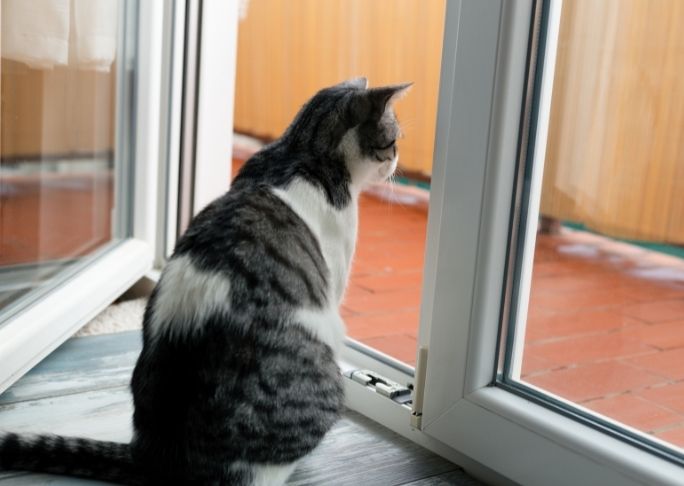
On the contrary, you’ll find it more challenging if you have an outdoor cat breed like Bengal, Bombay, Burmese, Cymric, Abyssinian, etc. These cat breeds will find it frustrating when denied access to the outdoors.
Also, training a cat to stay indoors will be much easier if you had a kitten that was not going out since birth than it will be if you are adopting a stray cat or a cat from a shelter that has been outdoors before.
Cats that have been indoors since birth could get afraid if they find themselves outdoors. Therefore, they don’t try to go out as often.
Nevertheless, you can train your cat to do many things, one of which is staying inside. You will need to be patient during training and take things gradually with your cat. Here are tips on how to train a cat not to go outdoors.
The training will take two phases. The first will be the training activities, and the second is making your cat very comfortable at home to reduce the desire to go out.
Table of Contents
How To Train Your Cat To Stay Indoors – Training Activities
Here are the steps to train your cat to stay at home.
1. Start Training At The Right Time
The perfect time to begin training is when it is undesirable to go outside; that way, you may face a little less resistance than you would when it’s lovely outdoors.
Therefore, winter or cold weather is usually an excellent time to start training for this purpose. Also, the timing of the day matters too. If your cat has just had a big meal, they might not be as crazy about the treat versus going outside.
2. Train By Limiting Outdoor Access
You have to begin by ensuring your pet doesn’t have easy access to sneak outdoors. Ensure doors and windows are not left open or within your pets’ reach. You need to remember that cats can jump relatively high, so windows should not be left open even if they seem pretty high up.
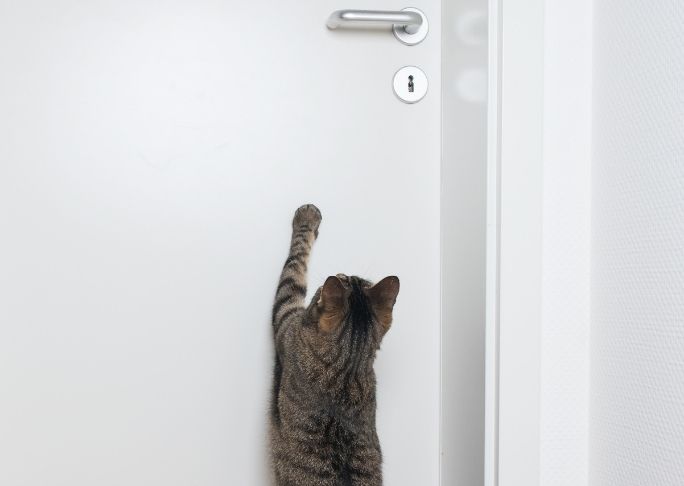
You will need to work with other household members to communicate with others to keep the door shut, or someone else may ruin your training efforts and accidentally let the cat out.
You should keep your pet far away when you or any other family member opens the door to go out. It’ll will be quite frustrating fro your cat if your cat gets to see people leave frequently and is not allowed to do so. This action can become one of the many causes of cat aggression and cat attacks.
Doors might not be a problem, but windows can be. You’ll need the sunlight and ventilation so, you’ll need a screen to cover the window when it’s open. Something your pet cannot get through.
Moreover, pets can be quite fast and dart out of the door quickly before you have a chance to stop them. So, before opening the doors to go out, make sure you put your pet in a different room or keep your pet occupied with something, so he doesn’t dash after you. You can try using a food puzzle or an interactive cat toy to distract him.
3. Train Your Cat To Stay Far Away From The Exit.
One of the most effective ways to teach a cat is using treats and a clicker. If we need to teach our cat not to go out when the door is open, then a clicker will make our pet pay attention and can be used to reward the cat for being far from the door.

First, you need to place your cat somewhere far from the door, maybe in another room entirely. Once your cat is seated and comfortable, press the clicker with one hand and use the other hand to give a treat.
Next, stroke, pat, or verbally commend the cat by calling their name, something like ‘Good Charlie’ in a gentle voice after giving the treat at that specific location.
Be sure to take the device with you when leaving so you can do the same action of providing treats and petting once you get back at that specific location.
Repeat the activity several times a day for the first seven to eight days. By this time, your cat should start to understand that location means treats and understand that they need to be there when the door is open to get the goodies. Reinforce the knowledge learned by repeating it for an additional week.
Clicker training can help your cat learn a lot. See our post on how to clicker train a cat for more information.
4. Train To Stay Indoors With Pet Proofing
You can pet-proof your doors and windows to prevent your cat from going outdoors. There are two ways to go about this; you can use a pet-proofing spray or a pet-proofing barrier.
For pet-proofing sprays, set the device near your doors, windows, and any other opening via which your pet can go outdoors. The equipment has motion sensors, and once your pet approaches the area, they release a liquid to repel the animal. Although the fluid is harmless, it isn’t enjoyable for your pet.
Pet proofing barriers work the same way, except instead of releasing liquid, your pet hears a loud noise which will cause them to retreat. Cats hate noise and according to various experts escaping from the scene is the most likely response.
5. Train Your Cat To Use A Litter Box
One of the reasons cats go out is to find a clean and hidden area to relieve themselves. This is normal cat behavior. If you have not trained your cat on using a litter box, you need to teach them how. Some cats may have already been trained by a previous owner. Other may get it instinctively if you buy the right type of cat litter box but some don’t so it’s best to train them. Here, you can see our quick and easy post on ‘how to litter train a cat.
Trending in Cats:
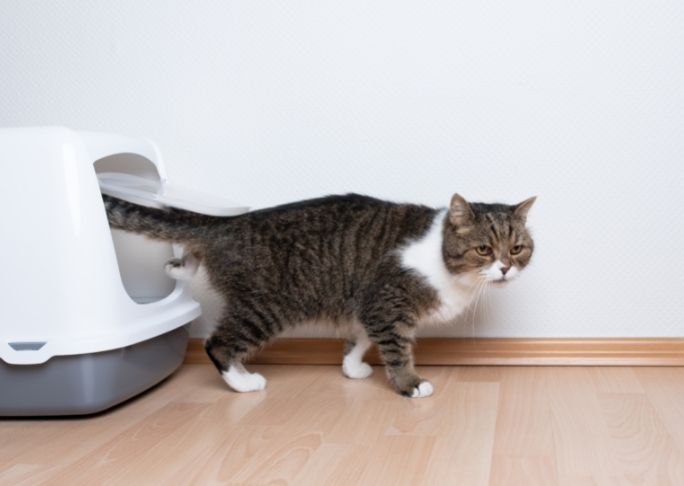
You also need to purchase an enclosed litter box if you don’t have one already and put it in a discrete area so your cat can feel safe using it. The chosen location should give a full view of the room but a quiet place and not a place with frequent foot traffic nor a tight place like a closet. See the best cat litter box for small apartments here that won’t take up much space.
The box also needs to be regularly cleaned as cats don’t like using dirty litter boxes or litter boxes with bad smells. See our tips with easy ways to remove litter box odor with items in your home.
6. Train Your Cat To Leash Walk And Take Him Out
If you have an older cat used to going out, you should consider leash training your cat and take your pet for outdoor walks once in a while.
It doesn’t have to be far; take your cat outdoors walking in your backyard or block is more than enough if you are not one for long walks. See our post on how to train a cat to walk on a leash for steps to do that. Going on supervised walks can help reduce the desire to go out for some days, but it’s not a long-term solution.

However, if you do like long walks and have a cat breed that loves the outdoors, you can take your cat on longer outdoor trips like hiking. Still, you will need to keep your pet leashed most of the trip so that even though your pet gets the benefit of being outdoors, your cat doesn’t get to roam free to ingest dangerous animals. See our post here on how to train a cat for hiking.
We don’t advise you to take younger cats outdoors. They need to learn how to stay and be happy indoors.
How To Keep Your Cat Inside By Making The House Very Comfortable
As mentioned earlier, on the flip side, you can train your cat to stay indoors by making the house so comfortable for your cat that he doesn’t want to leave it. Here’s how:
7. Provide Variety Of Indoor Activities
The outdoor is a great place for your pet to explore. If you’re going to keep your cat indoors, you’ll have to provide sufficient activities to make your home enjoyable. See it as a way of compensating your pet.
An easy way to go about this is by purchasing various cat toys. It would be best to have interactive and stimulating toys like plastic balls, stuffed mice, laser light, etc.
You should purchase interactive toys your pet can play with alone while away and toys that allow you to join in the play activity. That way, you can keep your pet occupied when you are gone and have something to play company and bond with him when you are back. See our post on the best cat toys for bored cats for some lovely toys.
If your pet loves you, he’ll want to be around you almost all the time, even if you’re indoors, so be sure to allocate a few minutes each day to play with your cat.
8. Plant Some Indoor Plants For Cats
Part of the lure of going outdoors is the fresh air, fresh smell and plants available outdoors. Your pet might enjoy chewing on some of these wild plants or need a cleaner fresh smelling apartment.
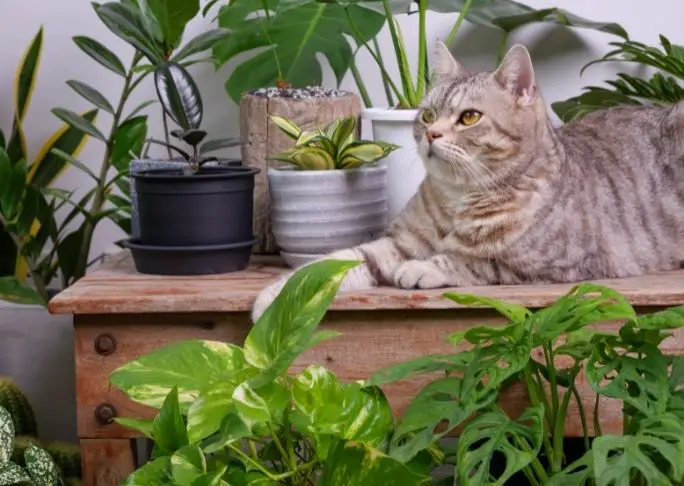
Try planting some indoor plants that cats like in your house. Cats love plants such as oat grass, catnip, alfalfa, and more. You can quickly grow these in pots. Talk to your nearby pet shop or ask your vet where you can get them.
You can also try using an air purifier to remove odors and freshen the smell of your home. See our top 10 best air purifiers for cat litter odors here.
9. Consider An Outdoor Yard Enclosure
If you have had an adult cat that has been outdoors most of its life, your cat may not be happy being restricted entirely.
You may wish to try building an enclosure (catio) in the yard, balcony or garage if you have the space to allow your cat a place to move around freely yet stay safe from dangers and attacks.
Also, consider purchasing a ready-to-go catio from amazon if you don’t have the time or energy to build one. The freedom with catios is kind of a middle ground approach better to transition outdoor cats to indoor cats. They get to go out but not too far and stay safe while outdoors.
10. Consider Getting Your Cat Spayed
One of the lures to go outdoors is the need to find partners to mate. Finding a partner to mate with is normal cat behavior of both indoor outdoor cats.
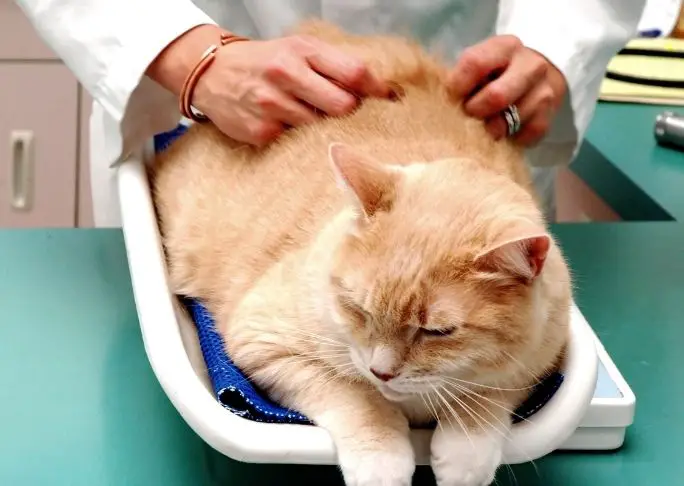
You will make training a cat to stay at home much easier if you get your cat spayed. Spaying can be done quickly by vets for cats over five months old. Set an appointment with a veterinarian today and get that sorted.
11. Don’t Shut Your Cat Out Totally.
Yes, we’re discussing how to train a cat to stay indoors but, I won’t recommend you completely cut your cat off from the outdoor life as there are some benefits to your pet.
Simply letting your cat view outside from an enclosed window is excellent. It’ll be best in a window where your pet could receive direct sunlight. You can set up a cat tree or cat hammock by the window, so your cat has a nice view.
12. Don’t Punish Your Cat.
Your cat might be very stubborn. You can put all measures in place to keep your pet indoors, yet your cat cries and complains about going outdoors. As a result, you may become tempted to punish your kitty, but I recommend that you do not.
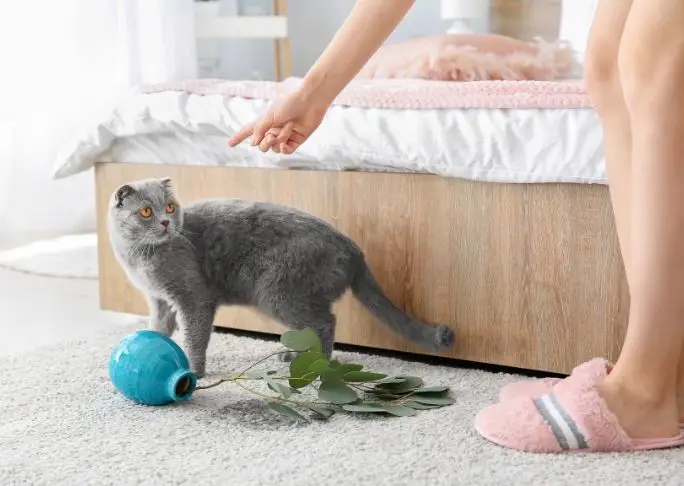
If you’ve got an outdoor cat, what you’re doing is changing his natural lifestyle. It will not be an easy change, so stubborn behaviors and a continuous drive to go outdoors should be expected.
Yes, you may need to take drastic measures and keep your cat locked in permanently if all the other steps mentioned here don’t seem to be working or satisfying your cat. In such cases, you would need to stay firm and unmoved by your cat’s cries for attention.
However, punishing your pet by beating him or yelling at him would do no good because he won’t learn from it. According to various experts, physical reprimands are among the most frequently utilized and least successful forms of punishment.
You can break your bond with your pet, and it could lead to fear and injuries. You could also lose your pet’s trust, which is very hard to get back. See these posts on apologizing to a cat and ‘how to make a cat feel happy for more tips.
Why do I need to keep my cat indoors?
When cats go outside, they may eat smaller animals due to their instincts to hunt. Many associations have pushed people to keep their cats indoors due to the damage done to birds and smaller animals.

On the other hand, cats also get attacked by other cats, raccoons, or skunks and get injured when they leave the house. They also come in contact with fleas, ticks, and other parasites.
Exposure to dangerous creatures and parasites is not the best for your pet’s health, as some of these animals may have diseases that could affect your cat or cause bad injuries that could cause you to lose your pet.
Moreover, studies have proven that indoor cats live much longer than cats that go outdoors. See our post on how does cat years equal human years for weird facts on how long cats live. These tips on how to train a cat to stay inside will help you keep your cat alive for longer.
You should hold on to this knowledge during the training process as you are not doing this just for yourself but also for your cat’s long-term health. Also see the video below for even more tips on why your cat wants to go out and what you can do to make them happy inside.
Final Thoughts
Things could seem difficult at first, especially when you own an outdoor cat breed. However, if you keep following the tips discussed here on how to train a cat to stay indoors, you’ll get your pet to love the indoor life and keep your kitty safe for longer. Don’t forget to share this page with all your friends.









